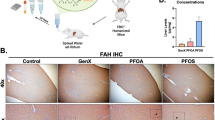Abstract
Background
Flutamide, a nonsteroidal antiandrogen used for treatment of prostate cancer, causes a temporary increase in transaminase and in some cases severe liver dysfunction. It is dominantly metabolized by cytochrome P450 (CYP) 1A2 into 2-hydroxyflutamide (OH-flutamide), which has stronger antiandrogenic activity without obvious cytotoxicity to cultured hepatocytes. We hypothesized that another subsidiary metabolite might be responsible for induction of hepatotoxicity.
Methods
Flutamide was administered daily to CYP1A2 knockout mice and parental SV129 mice to compare pharmacokinetics and appearance of hepatic toxicity.
Results
In the CYP1A2 knockout mice, the plasma concentration of flutamide maintained at a high level and OH-flutamide stayed low; a higher amount of FLU-1, an alternative metabolite of flutamide, was detected in urine. Simple repetitive administration of 800 mg/kg of flutamide for 28 days to CYP1A2 knockout mice did not show abnormal elevation of plasma alanine aminotransferase (ALT). However, after the knockout mice were fed with an amino acid-deficient diet for 2 weeks, which reduced the glutathione (GSH) content to 27% of the initial, administration of 400 mg/kg of flutamide increased ALT to over 200 IU/l and histopathologically moderate hepatitis developed. Since FLU-1 itself did not show cytotoxicity or reduce GSH content in vitro, a further metabolized molecule must cause the hepatotoxicity.
Conclusions
Blockade of CYP1A2 produced an unknown potential hepatotoxic molecule through FLU-1, and GSH might play an important role in diminishing the reactive hepatotoxic metabolite.
Similar content being viewed by others
References
Prostate Cancer (1995) ArticleTitleTrialists’ Collaborative Group. Maximum androgen blockade in advanced prostate cancer: an overview of 22 randomized trials with 3283 deaths in 5710 patients Lancet 346 265–9
B Schmitt TJ Wilt PF Schellhammer V DeMasi O Sartor ED Crawford et al. (2001) ArticleTitleCombined androgen blockade with nonsteroidal antiandrogens for advanced prostate cancer: a systematic review Urology 57 727–32 Occurrence Handle10.1016/S0090-4295(00)01086-4 Occurrence Handle1:STN:280:DC%2BD3M3ms1ajtw%3D%3D Occurrence Handle11306391
JL Gomez A Dupont L Cusan M Tremblay R Suburu M Lemay et al. (1992) ArticleTitleIncidence of liver toxicity associated with the use of flutamide in prostate cancer patients Am J Med 92 465–70 Occurrence Handle10.1016/0002-9343(92)90741-S Occurrence Handle1:STN:280:By2B2Mvoslw%3D Occurrence Handle1349790
Y Matsuzaki K Nishikawa (2003) ArticleTitleTherapeutic options for drug induced liver injury: the efficacy of UDCA based on EBM Nippon Shokakibyo Gakkai Zasshi 100 659–66 Occurrence Handle1:CAS:528:DC%2BD3sXmtFOmtLY%3D Occurrence Handle12833859
MS Shet M McPhaul CW Fisher NR Stallings RW Estabrook (1997) ArticleTitleMetabolism of the antiandrogenic drug (flutamide) by human CYP1A2 Drug Metab Dispos 25 1298–303 Occurrence Handle1:CAS:528:DyaK2sXntlOrsrg%3D Occurrence Handle9351907
N Watanabe R Goda T Irie K Yamashita (2001) ArticleTitleIn vitro effects of fluoroquinolon anti-bacterial agents on flutamide metabolism in human liver microsomes Jpn J Clin Pharmacol Ther 32 65–71 Occurrence Handle1:CAS:528:DC%2BD3MXktleqtrY%3D
E Radwanski G Perentesis S Symchowicz N Zampaglione (1989) ArticleTitleSingle and multiple dose pharmacokinetic evaluation of flutamide in normal geriatric volunteers J Clin Pharmacol 29 554–8 Occurrence Handle1:STN:280:BiaA38jlsFU%3D Occurrence Handle2754024
N Asakawa M Koyama Y Hashimoto K Yamashita (1995) ArticleTitleStudies on the metabolic fate of flutamide (4): biliary excretion, enterohepatic circulation, absorption from gastro-intestinal tract, metabolism and drug-metabolizing enzymes induction in rats Xenobio Metabol Dispos 10 470–83 Occurrence Handle1:CAS:528:DyaK2MXovFyhtr8%3D
D Fau D Eugene A Berson P Letteron B Fromenty C Fisch et al. (1994) ArticleTitleToxicity of the antiandrogen flutamide in isolated rat hepatocytes J Pharmacol Exp Ther 269 954–62 Occurrence Handle1:CAS:528:DyaK2cXksV2kt74%3D Occurrence Handle8014883
A Berson C Wolf C Chachaty C Fisch D Fau D Eugene et al. (1993) ArticleTitleMetabolic activation of the nitroaromatic antiandrogen flutamide by rat and human cytochrome P-450, including forms belonging to the 3A and 1A subfamilies J Pharmacol Exp Ther 265 366–72 Occurrence Handle1:CAS:528:DyaK3sXktVSht78%3D Occurrence Handle8386241
E Ichimura K Hara Y Matsuzaki M Doi (1999) ArticleTitleImprovement of flutamide-induced hepatotoxicity by ursodeoxycholic acid in male rats Acta Hepatol Jpn 40 227–34 Occurrence Handle1:CAS:528:DyaK1MXksFemt7s%3D
Y Nakagawa M Koyama M Matsumoto (1999) ArticleTitleFlutamide-induced hepatic disorder and serum concentrations of flutamide and its metabolites in patients with prostate cancer Acta Urol Jpn 45 821–6 Occurrence Handle1:STN:280:DC%2BD3c7isVKguw%3D%3D
S Ozono A Yamaguchi H Mochizuki T Kawakami K Fujimoto T Otani et al. (2002) ArticleTitleCaffeine test in predicting flutamide-induced hepatic injury in patients with prostate cancer Prostate Cancer Prostatic Dis 5 128–31 Occurrence Handle10.1038/sj.pcan.4500564 Occurrence Handle1:CAS:528:DC%2BD38XntFyls70%3D Occurrence Handle12497002
T Pineau P Fernandez-Salguero SS Lee T McPhail JM Ward Gonzales FJ. Neonatal (1995) ArticleTitlelethality associated with respiratory distress in mice lacking cytochrome P450 1A2 Proc Natl Acad Sci U S A 92 5134–8 Occurrence Handle1:CAS:528:DyaK2MXlvFyitbY%3D Occurrence Handle7761462
R Nakano M Haji T Yanase A Ogo R Takayanagi T Katsube et al. (1992) ArticleTitleA single amino acid substitution (Met786→Val) in the steroid-binding domain of human androgen receptor leads to complete androgen insensitivity syndrome J Clin Endocrinol Metab 74 1152–7 Occurrence Handle10.1210/jc.74.5.1152
PO Seglen (1976) ArticleTitlePreparation of isolated rat liver cells Methods Cell Biol 13 29–83 Occurrence Handle1:CAS:528:DyaE28XkslCgtbY%3D Occurrence Handle177845 Occurrence Handle10.1016/S0091-679X(08)61797-5
OH Lowry NJ Rosebrough AL Farr RJ Randall (1951) ArticleTitleProtein measurement with the folin phenol reagent J Biol Chem 193 265–75 Occurrence Handle1:CAS:528:DyaG38XhsVyrsw%3D%3D Occurrence Handle14907713
AF Boyne GL Ellman (1972) ArticleTitleA methodology for analysis of tissue sulfhydryl components Anal Biochem 46 639–53 Occurrence Handle10.1016/0003-2697(72)90335-1 Occurrence Handle1:CAS:528:DyaE38Xht1eluro%3D Occurrence Handle4623507
K Neda J Handa T Yamaguchi S Onikata M Hayashi K Nakamori et al. (1993) ArticleTitleA single dose toxicity study of flutamide in rats and dogs Pharmacometrics 45 135–40 Occurrence Handle1:CAS:528:DyaK3sXhs1SksLs%3D
Y Aizawa I Ikemoto K Kishimoto T Wada H Yamazaki Y Ohishi et al. (2003) ArticleTitleFlutamide-induced hepatic dysfunction in relation to steady-state plasma concentrations of flutamide and its metabolites Mol Cell Biochem 252 149–56 Occurrence Handle10.1023/A:1025560513308 Occurrence Handle1:CAS:528:DC%2BD3sXmvFequr8%3D Occurrence Handle14577588
Author information
Authors and Affiliations
Rights and permissions
About this article
Cite this article
Matsuzaki, Y., Nagai, D., Ichimura, E. et al. Metabolism and hepatic toxicity of flutamide in cytochrome P450 1A2 knockout SV129 mice. J Gastroenterol 41, 231–239 (2006). https://doi.org/10.1007/s00535-005-1749-y
Received:
Accepted:
Issue Date:
DOI: https://doi.org/10.1007/s00535-005-1749-y




